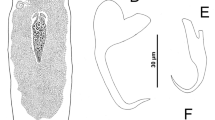Abstract
Halomonhystera parasitica n. sp. (Monhysterida: Monhysteridae) is described from the body-cavity and under the dorsal plates of the sandy beach amphipod Talorchestia brito Stebbing (Crustacea: Talitridae) in Portugal. The new species differs from previously described members of the genus by a combination of the following characters: four medium-sized cephalic setae; base of stoma with three blunt denticles; posterior dilated portion of stoma absent; amphids small, with width less than quarter of corresponding body width; amphids located less than two labial widths from anterior extremity; uterine eggs elliptical and unembryonated; gubernaculum lacks caudal process; and male tail with two separated pairs of postcloacal papillae and a single subterminal seta-like papilla. This is the first representative of the family Monhysteridae parasitic in the body-cavity of crustaceans. Approximately 48% of the amphipods examined contained various stages of H. parasitica.



Similar content being viewed by others

References
Allen, S. A. (1933). Parasites and commensals of North Carolina crayfish. Journal of the Elisha Mitchell Scientific Society, 49, 119–121.
Baylis, H. A. (1915). Two new species of Monhystera (Nematoda) inhabiting the gill-chambers of land-crabs. Annals and Magazine of Natural History, 16, 414–421.
Bellan-Santini, D., Karaman, G., Krapp-Schickel, G., Ledoyer, M., & Ruffo, S. (1993). Gammaridea (Melphidippidae to Talitridae), Ingolfiellidea, Caprellidea. In: Ruffo, S. (Ed.) The Amphipoda of the Mediterranean. No. 13 (Part 3). Memories de l'Institute Océanographique, Fondation Albert I, Monaco, 813 pp.
Chitwood, B. G. (1935). Nematodes parasitic in, and associated with, Crustacea, and descriptions of some new species and a new variety. Proceedings of the Heminthological Society of Washington, 2, 93–96.
Chitwood, B. G., & Murphy, D. G. (1964). Observations on two marine Monhysterids—their classification, cultivation, and behavior. Transactions of the American Microscopical Society, 83, 311–329.
Coomans, A., & Eyualem-Abebe. (2006). Order Monhysterida. In Eyualem-Abebe, I. Andrássy, & W. Traunspurger (Eds.), Freshwater nematodes: Ecology and taxonomy. Cambridge: CABI Publishing, pp. 574–603.
Fonseca, G., & Decraemer, W. (2008). State of the art of the free-living marine Monhysteridae (Nematoda). Journal of the Marine Biological Association of the United Kingdom, 88, 1371–1390.
Harrington, D., Anderson, R. C., Bird, G. M., & Mai, W. F. (1967). Occurrence of Monhystrella plectoides (Nematoda: Monhysteridae) within the white oogonia of Chara seylanica. Canadian Journal of Botany, 45, 973–974.
Lincoln, R. J. (1979). British marine Amphipoda: Gammaridea. London: British Museum (Natural History), 658 pp.
Lorenzen, S. (1986). Odontobius (Nematoda, Monhysteridae) from the baleen plates of baleen whales and its relationship to Gammarinema living on crustaceans. Zoologica Scripta, 15, 101–106.
Marques, J. C. (1989). Amphipoda (Crustacea) bentónicos da costa portuguesa: estudo taxonómico, ecológico e biogeográfico. PhD Thesis in Applied Ecology, Faculdade de Ciências e Tecnologia—Universidade de Coimbra, Museu e Laboratório Zoológico, Coimbra, Portugal, 394 pp.
Meyers, T. R., Elston, R. A., & Georgi, M. E. (1985). A monhysterid nematode parasitizing captive American oysters (Crassostrea virginica). Journal of Invertebrate Pathology, 46, 205–208.
Osche, G. (1955). Über die Vergesellschaftung von Nematoden und Crustaceen, mit einer Beschreibung von Matthesonema tylosa n. g., n. sp. (Nematoda) aus dem Kiemenraum einer Assel. Zoologischer Anzeiger, 155, 253–262.
Overgaard Nielsen, C. (1949). Studies on the soil microfauna. II. The soil inhabiting nematodes. Natura Jutlandica, 2, 1–131.
Schneider, W. (1932). Nematoden aus der Kiemenhöhle des Flusskrebses. Archiv für Hydrobiologie, 24, 629–636.
Steiner, G. (1958).Monhystera cameroni n. sp.—a nematode commensal of various crustaceans of the Magdalen Islands and Bay of Chaleur (Gulf of St. Lawrence). Canadian Journal of Zoology, 36, 269–278.
Wieser, W. (1953). Die Beziehung zwischen Muhdhöhlengestalt, Ernährungsweise und Vorkommen bei freilebenden marinen Nematoden. Arkiv för Zoologi, 4, 439–484.
Acknowledgement
Thanks are extended to the Pluriannual Program (CIIMAR) for supplying funds for the present study.
Author information
Authors and Affiliations
Corresponding author
Rights and permissions
About this article
Cite this article
Poinar, G., Duarte, D. & Santos, M.J. Halomonhystera parasitica n. sp. (Nematoda: Monhysteridae), a parasite of Talorchestia brito (Crustacea: Talitridae) in Portugal. Syst Parasitol 75, 53–58 (2010). https://doi.org/10.1007/s11230-009-9210-x
Received:
Accepted:
Published:
Issue Date:
DOI: https://doi.org/10.1007/s11230-009-9210-x



